
Step-by-Step Guide to Mortuary Dead Body Procedures
Why Proper Mortuary Dead Body Procedures Are Critical
Mortuary dead body handling represents one of the most important yet overlooked aspects of our healthcare and funeral service systems. When someone dies, their body follows a carefully orchestrated journey from the moment of death through final disposition.
Quick Overview of Mortuary Dead Body Procedures:
- Initial Documentation: Unique ID assignment, toe tagging, and chain of custody
- Preservation: Refrigeration at 2°C-4°C (36°F-39°F) to slow decomposition
- Examination: Visual inspection, autopsy if required, evidence collection
- Storage: Proper positioning in mortuary coolers with adequate ventilation
- Release: Transfer to funeral home or family with required documentation
This process provides families time to grieve and make arrangements, ensures public health safety through proper preservation, and maintains dignity throughout the final journey.
Modern mortuary facilities rely on refrigeration technology to preserve bodies safely. Bodies stored at standard mortuary temperatures of 2°C to 4°C can be preserved for several weeks, while forensic facilities may use freezing temperatures of -10°C to -50°C for longer-term storage.
The COVID-19 pandemic highlighted how crucial proper mortuary infrastructure is. When facilities reached capacity, temporary morgues were established in ice rinks and refrigerated trucks - demonstrating the vital role temperature control plays in respectful body care.
I'm Mortuary Cooler, a national-level mortuary cooler supplier with experience in mortuary dead body preservation systems and cold storage solutions. My expertise spans technical requirements, regulatory standards, and practical challenges that funeral homes and morgues face.
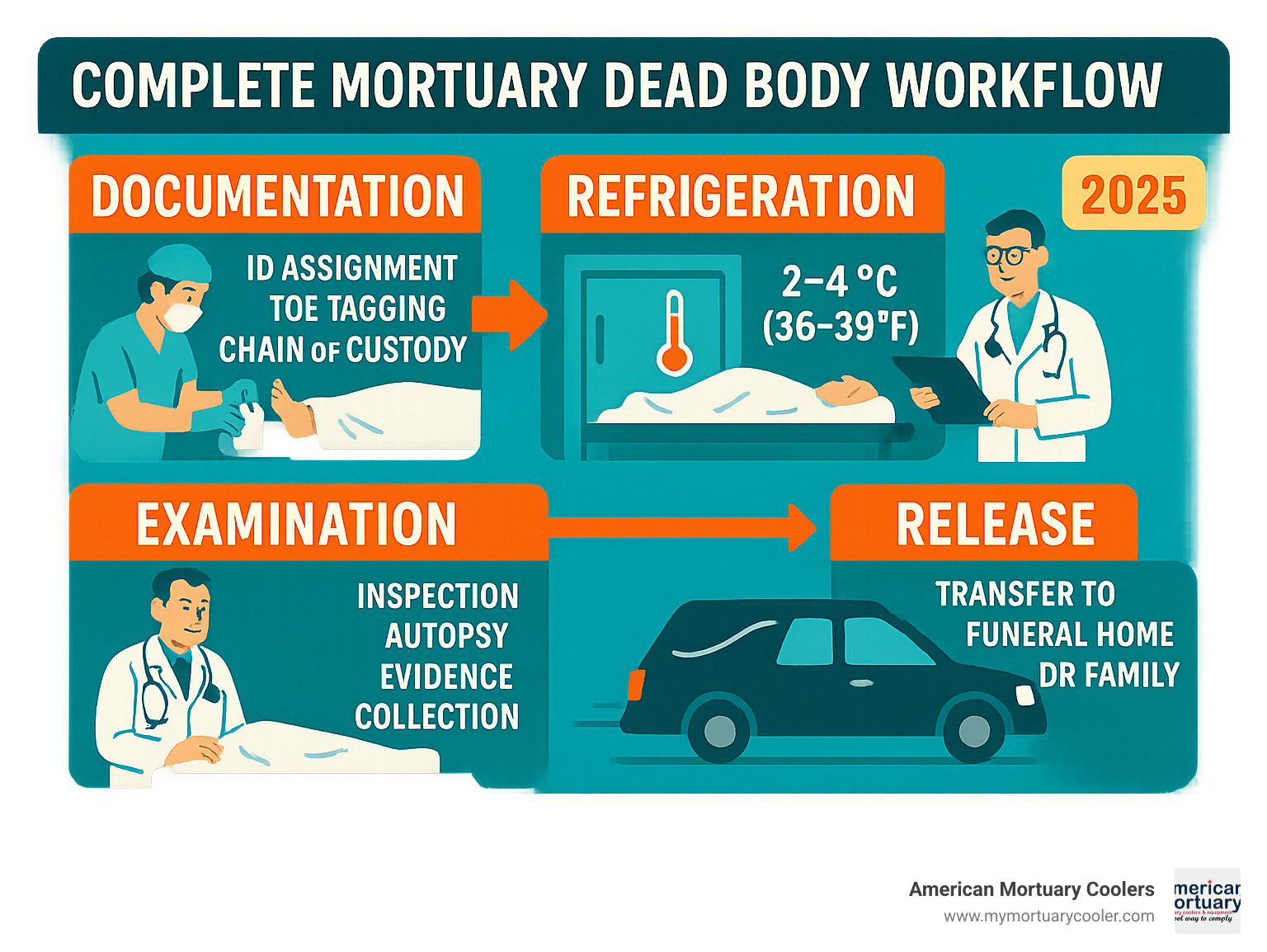
Key mortuary dead body vocabulary:
Why Understanding Procedures Matters
Understanding proper mortuary dead body procedures has real-world implications for safety, closure, legal compliance, and staff training.
From a safety perspective, proper handling prevents disease spread and protects mortuary workers. Universal precautions must be followed, treating every remains as potentially hazardous.
For families, understanding these procedures provides closure and peace of mind. Knowing their loved one is treated with dignity helps with the grieving process.
Legal compliance is critical. Bodies cannot remain unrefrigerated for more than 48 hours, and specific documentation must be maintained throughout custody.
Mortuary vs Morgue: Facility Basics
When someone passes away, their body may be taken to either a morgue or a mortuary - but these aren't the same thing. Understanding the difference helps explain how mortuary dead body handling works.
A morgue is the temporary holding area, usually inside a hospital or medical center, where bodies wait for identification, autopsy, or pickup. The word comes from old French meaning "to look at solemnly."
A mortuary is more comprehensive. While it might have a morgue area inside, it's a full-service facility handling everything from embalming to cremations to funeral preparations. Most mortuaries are standalone funeral homes.
"Waiting mortuaries" in the 1800s were places where recently deceased people were monitored for signs of life. Attendants watched for movement to prevent premature burial, sometimes attaching bells to bodies.
When disasters strike, surge morgues appear in unexpected places. During COVID-19, ice skating rinks and refrigerated trucks became temporary morgues, showing how crucial proper refrigeration is.
Scientific research on facility terminology and more info about morgue coolers provide deeper insights.
Key Differences at a Glance
| Aspect | Morgue | Mortuary |
|---|---|---|
| Primary Function | Temporary storage, autopsy | Full funeral services |
| Location | Hospital-based | Standalone facility |
| Temperature Range | 2°C-4°C (standard), -10°C to -50°C (forensic) | 36°F-39°F (2°C-4°C) |
| Staff Roles | Medical examiners, pathologists | Funeral directors, embalmers |
| Services | Storage, identification, autopsy | Embalming, cremation, viewing |
| Storage Duration | Hours to weeks | Days to weeks |
Evolution of Design & Capacity
Modern facilities use modular cooler systems that expand as needed, plus specialized bariatric refrigeration units for larger individuals.
The pandemic showed the importance of surge planning. Ice rinks becoming temporary morgues and refrigerated trucks serving as mobile storage demonstrated the need for flexible refrigeration solutions.
At American Mortuary Coolers, we focus on custom solutions that handle both daily operations and unexpected surges, serving families with dignity whether it's routine operations or community crises.
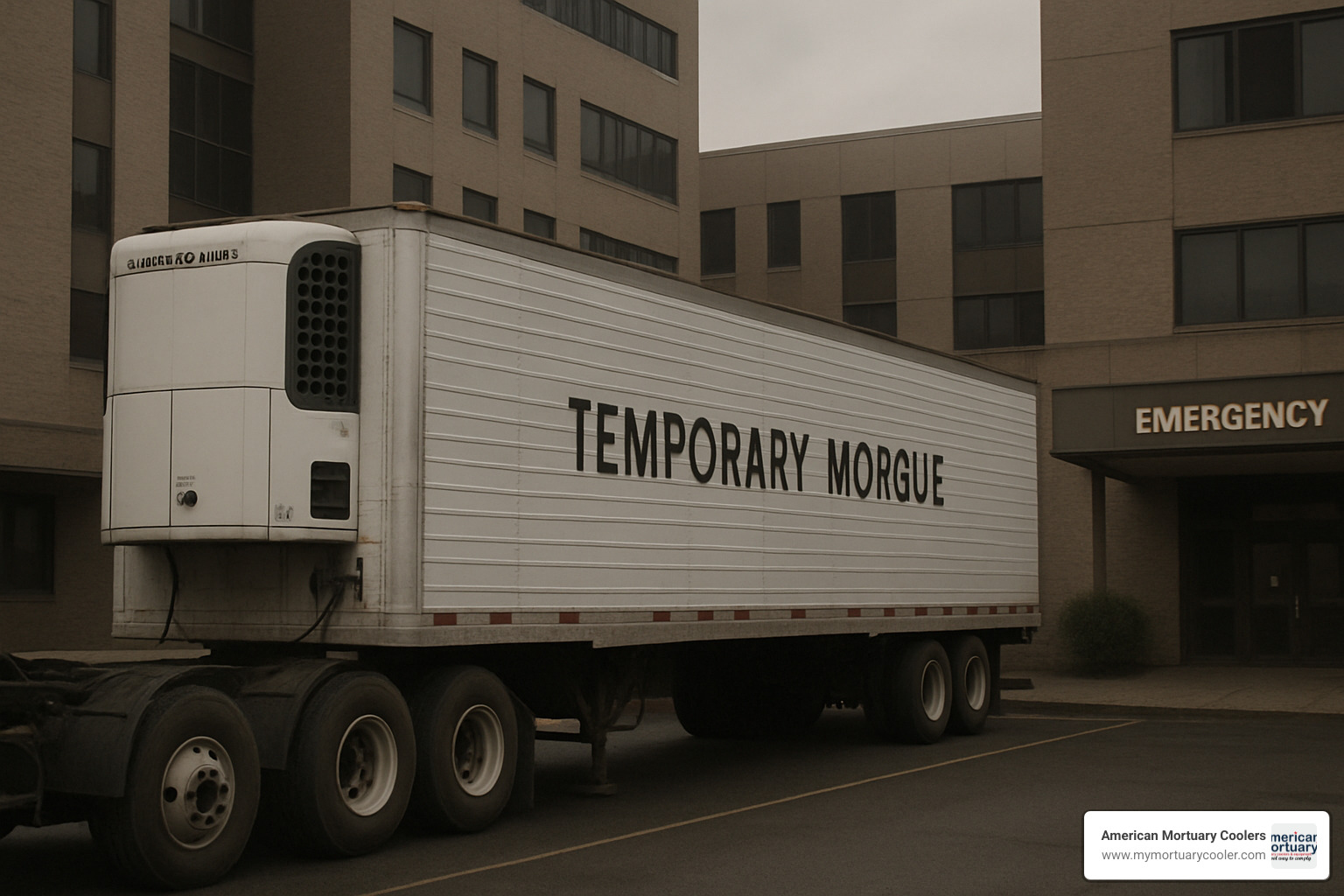
Step-by-Step Handling of a Mortuary Dead Body
Proper handling of a mortuary dead body follows a systematic workflow designed to maintain dignity, preserve evidence, and ensure public health safety. This process begins when a body arrives and continues through final disposition.
The intake workflow starts with establishing chain of custody. Every person handling the body must be documented. Personal protective equipment (PPE) is mandatory - gloves, gowns, masks, and eye protection.
Documentation is critical. Each body receives a unique identifying number that follows through every step. Toe tags are attached immediately and must be waterproof and permanent.
Cold room transfer happens quickly after documentation. Bodies should move to refrigerated storage within the 48-hour legal limit for unrefrigerated storage.
Arrival & Documentation of the Mortuary Dead Body
When a mortuary dead body arrives, documentation comes first. The body typically arrives in a sealed body bag, maintaining chain of custody and preventing contamination.
A unique identifier is assigned immediately - sequential number, barcode, or tracking system. This ID becomes the primary reference for all documentation and must be visible on paperwork and storage locations.
Scene photos may accompany the body, especially in forensic cases. All personal property is logged separately and stored according to custody requirements.
Intake documentation includes:
- Time and date of arrival
- Transporting agency or person
- Condition of body bag and seals
- Preliminary visual assessment
- Personal property inventory
- Next of kin information (if available)
Initial Examination & Tagging
Initial examination of a mortuary dead body is conducted by qualified personnel. This visual examination focuses on identification and preliminary assessment.
Fingerprinting may be performed, especially for unidentified bodies or forensic cases. Digital systems have largely replaced ink-based methods.
Evidence collection follows strict protocols. Trace evidence, clothing, or personal effects are bagged and labeled separately. Paper bags are preferred over plastic for items like clothing.
Toe tags must include:
- Unique facility ID number
- Name (if known)
- Date of arrival
- Storage location
- Special handling instructions
More info about body storage solutions provides additional identification system details.
Storage, Autopsy & Evidence Collection
Proper storage requires maintaining temperatures between 2°C and 4°C (36°F to 39°F) in standard mortuary coolers. This slows decomposition without freezing, which could interfere with autopsy procedures.
The autopsy suite is specialized for detailed examination. Not all bodies require autopsy - this decision is made by medical examiner or coroner based on circumstances.
When autopsy is required, the pathologist performs:
- External examination and photography
- Internal examination of organs
- Collection of tissue samples
- Documentation of findings
- Death certificate completion
Forensic sampling may include toxicology specimens, DNA samples, and trace evidence. Bodies should not be stacked during storage unless proper shelving is used.
Release, Transport & Final Disposition
Release requires proper authorization and documentation. Only legally authorized persons can claim a body with completed paperwork.
Embalming is optional under federal law except in specific circumstances. When performed, it typically requires one gallon of solution per 50-75 pounds of body weight.
Transport may involve refrigerated hearses for longer distances, maintaining proper temperature throughout the journey.
Final disposition options include:
- Traditional burial in casket
- Cremation (now over 50% of US cases)
- Green burial without embalming
- Alkaline hydrolysis (where legal)
- Human composting (in select states)
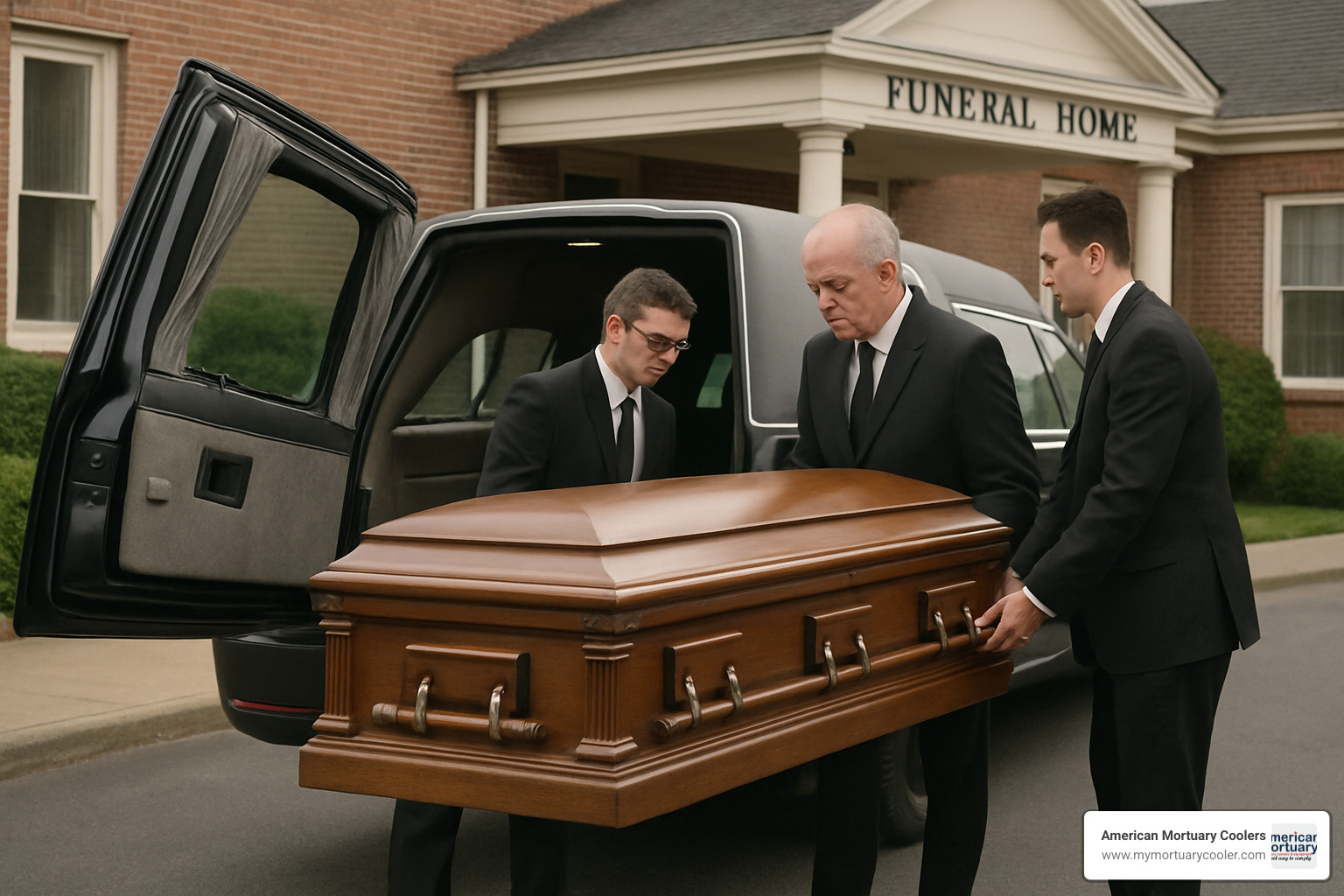
Preservation Technology & Equipment
When preserving a mortuary dead body, temperature control is everything. The technology breaks down into positive and negative temperature storage, each serving different purposes.
Positive temperature chambers operate between 2°C and 4°C (36°F to 39°F). This standard mortuary storage slows decomposition while keeping bodies suitable for viewing and autopsy. Most bodies preserve safely at these temperatures for several weeks.
Negative temperature chambers operate at -10°C to -50°C (14°F to -58°F). These forensic freezers are used when bodies need long-term storage while awaiting identification. Freezing makes autopsy procedures challenging, so it's reserved for specific situations.
At American Mortuary Coolers, we craft custom systems rather than one-size-fits-all solutions. Every facility has unique needs.
Body lifts and hydraulic tables are essential for staff safety. A mortuary dead body can weigh significantly more than a living person, and manual lifting poses serious injury risks.
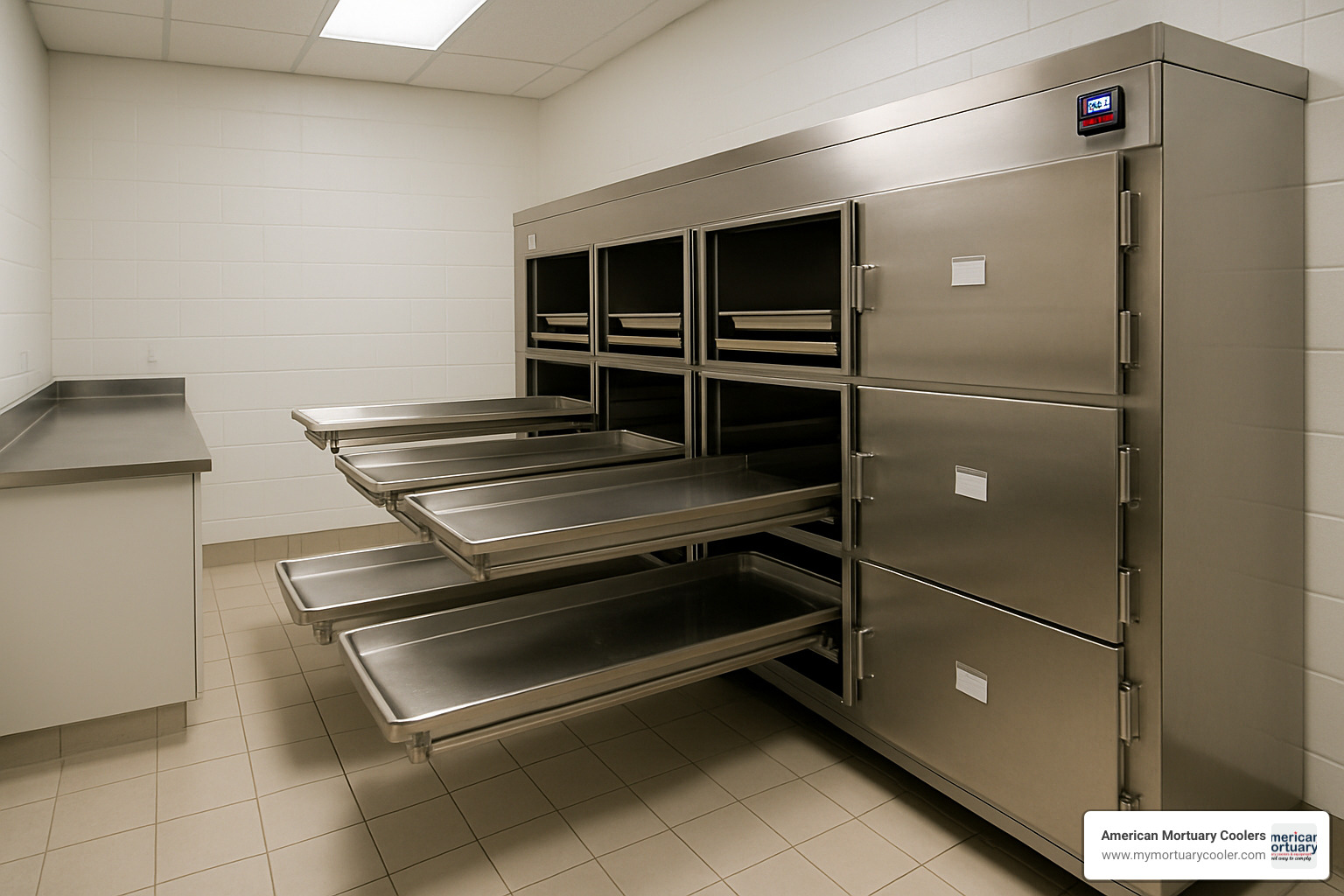
Energy efficiency matters for 24/7 systems. Key factors include unit size, local climate, and insulation quality. High-quality insulation costs more upfront but pays for itself through lower energy bills.
Scientific research on cold storage continues refining optimal preservation conditions.
Cooling vs Freezing Strategies
Choosing between cooling and freezing matches technology to specific needs.
Walk-in coolers offer maximum capacity and flexibility for busy facilities. These accommodate multiple bodies on adjustable shelving with walk-in access.
Plug-in body boxes are economical for smaller operations. These compact units handle one to six bodies and plug into standard outlets.
Surge trailers are mobile refrigerated units deployable anywhere within hours - crucial during mass casualty events.
Decision factors include expected storage duration, autopsy access needs, available space and power, budget constraints, and local climate.
More info about cooler temperatures covers technical temperature selection aspects.
Embalming & Chemical Preservation
Embalming offers alternative preservation for mortuary dead body care through two main techniques.
The arterial method injects formaldehyde-based solution through the carotid artery while draining blood through the jugular vein.
The cavity method addresses internal organs using a trocar to remove fluids and gases, then inject cavity fluid.
Formaldehyde concentrations typically range from 10-40%. Growing safety and environmental concerns drive development of alternative chemicals with lower toxicity.
Infection control requires strict universal precautions with proper ventilation removing chemical vapors while protecting staff.
Essential Tools & Equipment List
Proper mortuary equipment includes:
Body handling: Hydraulic lifts rated 1000+ pounds, transfer stretchers with multiple grip points, waterproof body bags, positioning blocks
Examination: Autopsy saws, trocars for cavity work, precision scales, photography equipment
Safety: Universal precaution PPE kits, eye wash stations, ventilation systems, spill cleanup materials
Storage: Temperature monitoring with alarms, backup power, drainage systems, security cameras
Documentation: Waterproof labels, chain of custody forms, digital ID systems, inventory tracking software
At American Mortuary Coolers, we help facilities integrate these components with our cooling systems, creating complete solutions delivered anywhere in the contiguous 48 states.
Legal, Ethical, Cultural & Emotional Dimensions
Handling a mortuary dead body involves legal requirements, ethical responsibilities, cultural traditions, and personal emotions. Getting this right honors the deceased and supports grieving families.
Most states have 72-hour burial laws requiring burial or cremation within three days unless properly refrigerated. This becomes complex with weekends, holidays, and family travel needs. Reliable refrigeration gives families time for thoughtful decisions.
Consent forms are required for procedures beyond basic storage. Autopsy, embalming, organ donation all require authorization from legally recognized next of kin.
Dignity is the foundation of everything we do. Every staff member must treat each mortuary dead body with respect, maintaining privacy and avoiding unnecessary exposure. How we handle someone's final journey affects family healing.
The David Fuller case in the UK highlighted how vulnerable the deceased can be. Many facilities now use CCTV security systems and strict access controls to maintain public trust.
Staff burnout is common in mortuary work. Dealing with death daily and supporting grieving families takes an emotional toll. Facilities investing in proper support systems provide better family care.
Family grief drives much of what we do. Families in shock need time to process, gather relatives, and plan services. Proper mortuary dead body preservation gives them precious time without pressure.
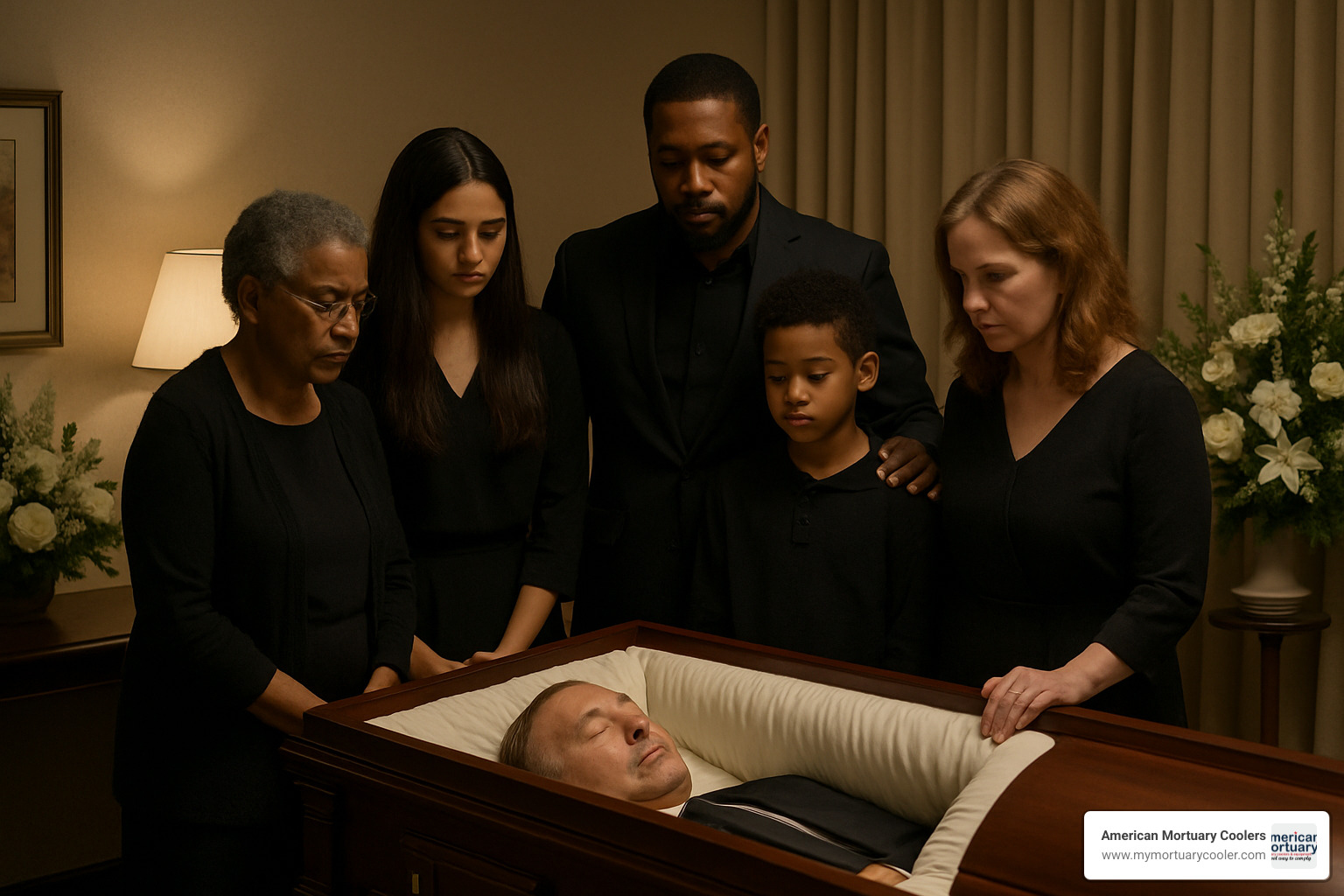
Global Variations in Mortuary Practice
Different cultures have specific requirements for mortuary dead body handling that we must respect.
Islamic tradition typically requires burial within 24 hours, creating challenges with standard procedures. Many facilities work with Islamic communities to streamline processes while maintaining compliance.
Hindu cremation rites involve specific preparation including washing, wrapping in white cloth, and anointing with oils. Families often participate directly, requiring appropriate space.
U.S. versus EU regulations show different approaches. European practices emphasize shorter storage and less chemical preservation, while U.S. practices involve longer storage and more extensive embalming.
Pandemic adaptations forced changes in traditional practices worldwide. COVID-19 required modifications to viewing procedures and storage capacity that challenged cultural norms.
Ethics & Security for the Mortuary Dead Body
Chain of custody protocols ensure every mortuary dead body is properly tracked throughout facility time. This means documenting access, examinations, and any changes.
Privacy protection goes beyond legal requirements to ethical obligations. Families trust us with precious relationships, earned through consistent, respectful procedures.
Cultural sensitivity requires ongoing education and flexibility. Staff should understand diverse beliefs about death, body preparation, and final disposition.
CCTV security and access controls serve dignity by ensuring only authorized personnel interact with the deceased. Families find comfort knowing their loved one is protected.
At American Mortuary Coolers, we understand our refrigeration systems are part of a complex, deeply human process. More info about mortuary fridges discusses how temperature control supports both technical requirements and cultural needs.
Frequently Asked Questions about Mortuary Dead Body Procedures
When families face the loss of a loved one, they often have practical questions about what happens next. Understanding the basics of mortuary dead body procedures can provide comfort during a difficult time and help families make informed decisions.
These are the most common questions we hear from families and funeral professionals about mortuary storage and handling procedures.
How long can a body stay refrigerated before burial?
A mortuary dead body can remain safely refrigerated for several weeks when properly stored at the correct temperature. Our mortuary coolers maintain bodies at 2°C to 4°C (36°F to 39°F), which significantly slows decomposition while preserving the body's condition for viewing and services.
The exact storage duration depends on several factors. Bodies that were healthy at the time of death typically preserve better than those who were ill. The effectiveness of your refrigeration system matters too - consistent temperature control is crucial for optimal preservation.
Legal requirements also play a role. Most states require burial or cremation within 72 hours unless the body is properly refrigerated. Once refrigeration begins, families have much more flexibility in scheduling services and making arrangements.
Embalmed bodies can be stored even longer - potentially for months - though the quality may gradually decline over time. However, many families find that refrigeration alone provides sufficient preservation for their needs without the added cost and chemicals of embalming.
Who can authorize an autopsy on a mortuary dead body?
Autopsy authorization follows specific legal protocols that vary by jurisdiction. Medical examiners and coroners have the authority to order autopsies for deaths that are sudden, unexpected, violent, or suspicious. In these cases, the autopsy may proceed regardless of family wishes because it serves a legal or public health purpose.
Family members can also request autopsies, particularly when they have questions about the cause of death or want additional medical information. However, families requesting autopsy are typically responsible for the associated costs, which can range from $3,000 to $5,000 or more.
Religious and cultural objections are often considered by authorities. Many jurisdictions will work with families to find alternative examination methods when possible, such as external examination or limited internal examination that respects cultural beliefs.
The timing of autopsy requests matters too. It's much easier to arrange an autopsy immediately after death than after embalming or extended storage, so families should discuss this option early in the process if they're considering it.
What temperatures do mortuary coolers and freezers use?
Standard mortuary coolers operate at 2°C to 4°C (36°F to 39°F) for routine mortuary dead body storage. This temperature range provides the perfect balance - cold enough to slow decomposition significantly, but not so cold that it interferes with viewing or autopsy procedures.
Forensic freezers use much colder temperatures, typically -10°C to -50°C (14°F to -58°F). These are primarily used in medical examiner offices and forensic institutes where bodies may need long-term storage while awaiting identification or during lengthy legal proceedings.
The choice between cooling and freezing depends on your specific needs. Cooling is preferred for most funeral home applications because it maintains the body's natural appearance and texture for viewing and preparation. Freezing is necessary only for extended storage periods or when decomposition must be stopped completely.
At American Mortuary Coolers, we help facilities choose the right temperature range for their specific needs. Our systems maintain precise temperature control with backup systems to ensure consistent preservation even during power outages.
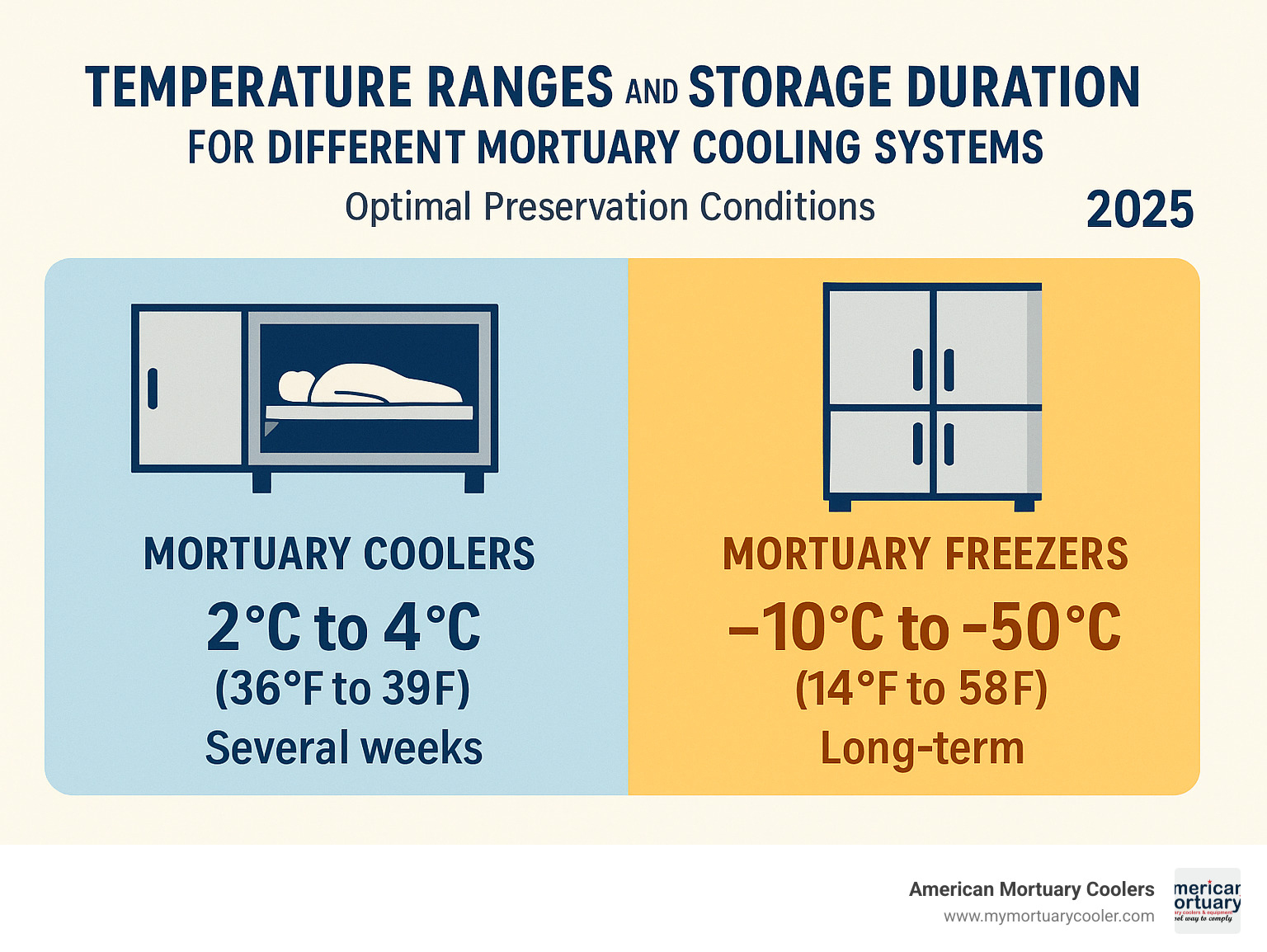
Energy efficiency is another consideration when selecting operating temperatures. Systems running at standard mortuary temperatures (2°C to 4°C) use significantly less energy than forensic freezers, which can help control operating costs over time.
Conclusion
The journey through mortuary dead body procedures reveals how we care for those who've passed on. It's about honoring dignity while supporting families during difficult moments.
Every element works together: initial documentation ensures no one is forgotten, precise refrigeration at 2°C to 4°C gives families time for thoughtful decisions, careful examination provides needed answers, and respectful final release helps families begin healing.
Technology has transformed mortuary care while the core mission remains unchanged. We've evolved from Victorian waiting mortuaries to today's sophisticated refrigeration networks and mobile surge units. Yet the fundamental goal stays the same: treating every person with dignity and respect.
At American Mortuary Coolers, we've supported this mission across Tennessee, Georgia, Illinois, South Carolina, Texas, California, New York, and Pennsylvania. Each facility has taught us about unique challenges funeral directors face.
That's why we focus on custom solutions rather than one-size-fits-all approaches. Your equipment needs to fit your space, budget, and community needs. Your systems need reliability when families count on you most.
COVID-19 showed how quickly mortuary needs can change. Facilities converting ice rinks and deploying refrigerated trucks reinforced that preparation and quality equipment aren't luxuries - they're necessities.
Looking ahead, I see continued evolution. Green burial options are growing. Alkaline hydrolysis is becoming legal in more states. Families ask more questions about preservation methods and environmental impact. Through all changes, the need for reliable, respectful mortuary dead body handling remains constant.
Whether you're considering your first mortuary cooler or upgrading aging equipment, we're here to help. Our direct delivery across the contiguous 48 states means we support your facility wherever located. Our understanding of both technical and human sides means we recommend solutions that truly serve your community.
Ready to explore how modern refrigeration technology can improve your mortuary operations? More info about mortuary cooler options will show you the full range of possibilities for creating a facility that honors both the deceased and the families who trust you with their care.



